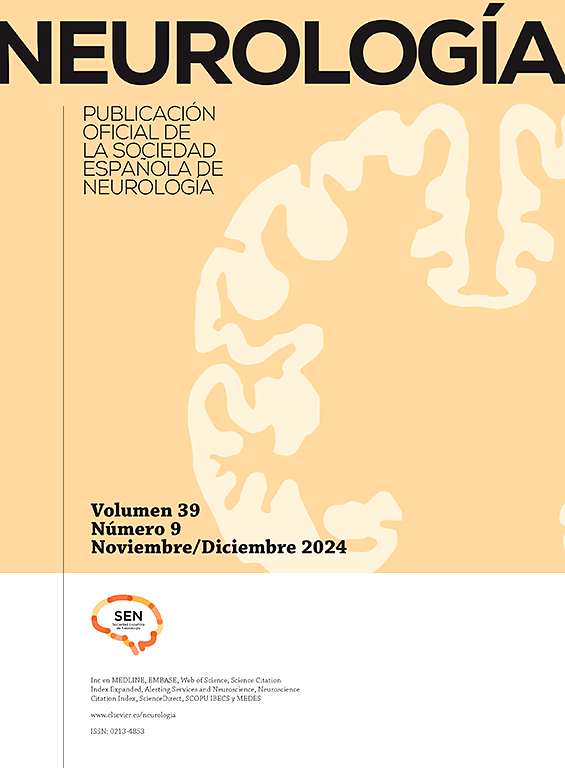Mortalidad y recurrencia a largo plazo del ictus isquémico en adultos jóvenes en Aragón
IF 3.1
4区 医学
Q2 CLINICAL NEUROLOGY
引用次数: 0
Abstract
Introduction
The incidence of ischemic stroke in young adults is increasing worldwide, and it is not uncommon in our region. It is associated with the presence of traditional vascular risk factors. However, there is little information about its prognosis, unlike other age groups. The objective of this study is to determine mortality, both in the short and long term follow-up, and the long-term follow-up recurrence of ischemic stroke in young adult patients in Aragon, making up the first study of this kind in Spain, and one of the few that addresses this issue in Europe.
Methods
Multicenter, observational, retrospective study of all patients between 18 and 50 years old who were admitted for an ischemic stroke in any hospital in Aragon between 2005-2015. The follow-up was carried out until March 31, 2021. Mortality, causes of death and recurrence of cerebrovascular events were collected, stratifying the sample based on the sex and age group of the patients. Logistic and Cox regression models were used to determine the factors associated with mortality and recurrence.
Results
721 patients were included (697 with long-term follow-up). Mortality was 3.3% in the first 30 days. Long-term mortality and recurrence was 9.2% and 11.9% at a median of 10.1 years of follow-up. The most frequent cause of death in the short term was of neurovascular origin and in the long term was cancer. Having a NIHSS > 15 was associated with higher short-term mortality. Arterial hypertension, diabetes mellitus, excessive alcohol consumption, atrial fibrillation and peripheral vascular disease were associated with long-term mortality. A history of previous stroke, diabetes mellitus, and atherothrombotic etiology were associated with a higher cumulative risk of stroke recurrence.
Conclusions
Mortality and recurrence of ischemic stroke in young adults in Aragon, although lower than that described by other studies, is by no means negligible and is associated with the presence of traditional vascular risk factors.
阿拉贡年轻人缺血性中风的死亡率和长期复发
在世界范围内,年轻人缺血性脑卒中的发病率正在上升,在我们地区并不罕见。它与传统血管危险因素的存在有关。然而,与其他年龄组不同,关于其预后的信息很少。本研究的目的是确定死亡率,包括短期和长期随访,以及阿拉贡年轻成年患者缺血性中风的长期随访复发,这是西班牙第一个此类研究,也是欧洲少数几个解决这一问题的研究之一。方法采用多中心、观察性、回顾性研究方法,对2005-2015年阿拉贡某医院收治的18 ~ 50岁缺血性脑卒中患者进行研究。随访一直持续到2021年3月31日。收集患者的死亡率、死亡原因和脑血管事件复发情况,并根据患者的性别和年龄组对样本进行分层。采用Logistic和Cox回归模型确定与死亡率和复发率相关的因素。结果共纳入721例患者,其中长期随访697例。前30天死亡率为3.3%。随访中位数为10.1年,长期死亡率和复发率分别为9.2%和11.9%。短期内最常见的死亡原因是神经血管起源,长期死亡原因是癌症。拥有NIHSS >;15岁与较高的短期死亡率相关。动脉高血压、糖尿病、过度饮酒、心房颤动和周围血管疾病与长期死亡率相关。既往卒中史、糖尿病和动脉粥样硬化血栓病因学与卒中复发的累积风险较高相关。结论阿拉贡地区青壮年缺血性卒中的死亡率和复发率虽然低于其他研究,但不可忽视,与传统血管危险因素的存在有关。
本文章由计算机程序翻译,如有差异,请以英文原文为准。
求助全文
约1分钟内获得全文
求助全文
来源期刊

Neurologia
医学-临床神经学
CiteScore
5.90
自引率
2.60%
发文量
135
审稿时长
48 days
期刊介绍:
Neurología es la revista oficial de la Sociedad Española de Neurología y publica, desde 1986 contribuciones científicas en el campo de la neurología clínica y experimental. Los contenidos de Neurología abarcan desde la neuroepidemiología, la clínica neurológica, la gestión y asistencia neurológica y la terapéutica, a la investigación básica en neurociencias aplicada a la neurología. Las áreas temáticas de la revistas incluyen la neurologia infantil, la neuropsicología, la neurorehabilitación y la neurogeriatría. Los artículos publicados en Neurología siguen un proceso de revisión por doble ciego a fin de que los trabajos sean seleccionados atendiendo a su calidad, originalidad e interés y así estén sometidos a un proceso de mejora. El formato de artículos incluye Editoriales, Originales, Revisiones y Cartas al Editor, Neurología es el vehículo de información científica de reconocida calidad en profesionales interesados en la neurología que utilizan el español, como demuestra su inclusión en los más prestigiosos y selectivos índices bibliográficos del mundo.
 求助内容:
求助内容: 应助结果提醒方式:
应助结果提醒方式:


